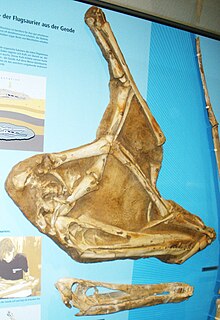
Tapejara is a genus of Brazilian pterosaur from the Cretaceous Period. Tapejara crests consisted of a semicircular crest over the snout, and a bony prong which extended back behind the head. It was a small pterosaur, with a wingspan of approximately 1.23–1.3 metres (4.0–4.3 ft).

Cearadactylus is a genus of large anhanguerid pterodactyloid pterosaur from the Romualdo Formation of Brazil, South America. Fossil remains of Cearadactylus dated back to the Albian stage of the Early Cretaceous period, about 112 million years ago. The only known species is C. atrox, described and named in 1985 by Giuseppe Leonardi and Guido Borgomanero. The name refers to the Brazilian state Ceará, and combines this with Greek daktylos, "finger", a reference to the wing finger of pterosaurs. The Latin atrox means "frightful", a reference to the fearsome dentition of the species.

Tupuxuara is a genus of large, crested, and toothless pterodactyloid pterosaur from the Early Cretaceous period of what is now the Romualdo Formation of the Santana Group, Brazil, about 125 to 112 million years ago. Tupuxuara is a close relative of Thalassodromeus, and both form a group that is either called Thalassodrominae or Thalassodromidae.

Tropeognathus is a genus of large pterosaurs from the late Early Cretaceous of South America. This genus is considered to be a member of the family Anhangueridae, however, several studies have also recovered it within another family called Ornithocheiridae. Both of these families are diverse groups of pterosaurs known for their keel-tipped snouts and large size. Tropeognathus is regarded as the largest pterosaur found in the Southern Hemisphere, only rivaled by the huge azhdarchids. The type and only species is Tropeognathus mesembrinus. Fossil remains of Tropeognathus have been recovered from the Romualdo Formation, which is a Lagerstätte located in the Santana Group of the Araripe Basin in northeastern Brazil.

Thalassodromeus is a genus of pterosaur that lived in what is now Brazil during the Early Cretaceous period, about a hundred million years ago. The original skull, discovered in 1983 in the Araripe Basin of northeastern Brazil, was collected in several pieces. In 2002, the skull was made the holotype specimen of Thalassodromeus sethi by palaeontologists Alexander Kellner and Diogenes de Almeida Campos. The generic name means "sea runner", and the specific name refers to the Egyptian god Seth due to its crest being supposedly reminiscent of Seth's crown. Other scholars have pointed out that the crest was instead similar to the crown of Amon. A jaw tip was assigned to T. sethi in 2005, became the basis of the new genus Banguela in 2014, and assigned back to Thalassodromeus as the species T. oberlii in 2018. Another species was described in 2015 based on a supposed crest fragment, but this was later shown to be part of a turtle shell.
Anhanguera is a genus of pterodactyloid pterosaur known from the Early Cretaceous Romualdo Formation of Brazil and the Late Cretaceous Kem Kem Group of Morocco. This pterosaur is closely related to Ornithocheirus, but belongs in the family Anhangueridae. The generic name comes from the Tupi words añanga, meaning "spirit protector of the animals" + wera "bygone".
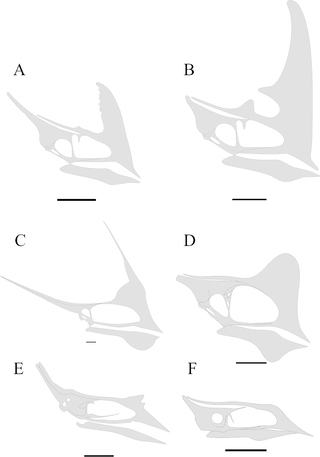
Tapejaridae are a family of pterodactyloid pterosaurs from the Cretaceous period. Members are currently known from Brazil, England, Hungary, Morocco, Spain, the United States, and China. The most primitive genera were found in China, indicating that the family has an Asian origin.
Araripedactylus was a large genus of pterodactyloid pterosaur, known from a single wing bone found in the Early Cretaceous Santana Formation of Brazil.
Araripesaurus is a genus a pterosaur belonging to the suborder Pterodactyloidea, it was discovered in the Romualdo Formation of the Santana Group in northeastern Brazil, which dates back to the Aptian and Albian of the Early Cretaceous. The type species is A. castilhoi.
Brasileodactylus a genus of pterosaur from the Aptian-age lower Santana formation of Chapada do Araripe, Ceará, Brazil.
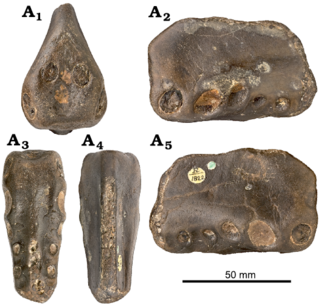
Coloborhynchus is a genus of pterodactyloid pterosaur belonging to the family Anhangueridae, though it has also been recovered as a member of the Ornithocheiridae in some studies. Coloborhynchus is known from the Lower Cretaceous of England, and depending on which species are included, possibly the Albian and Cenomanian ages as well. Coloborhynchus was once thought to be the largest known toothed pterosaur, however, a specimen of the closely related Tropeognathus is now thought to have had a larger wingspan.

Ludodactylus is a genus of anhanguerid pterodactyloid pterosaur from the Early Cretaceous period of what is now the Crato Formation of the Araripe Basin in Ceará, Brazil. The type and only species is L. sibbicki. The generic name Ludodactylus refers to the fact that the animal had the combination of teeth and a Pteranodon-like head crest, similar to many toy pterosaurs, and no such creature was known to exist until the discovery of Ludodactylus. However, Ludodactylus is not the only pterosaur known to possess these features, its very close relative Caulkicephalus is another example.

Liaoningopterus, sometimes misspelled as "Liaoningopteryx", was a genus of anhanguerid pterodactyloid pterosaur from the Barremian-Aptian-age Lower Cretaceous Jiufotang Formation of Chaoyang, Liaoning, China.

Tupandactylus is a genus of tapejarid pterodactyloid pterosaur from the Early Cretaceous Crato Formation of Brazil.

Ornithocheiridae is a group of pterosaurs within the suborder Pterodactyloidea. These pterosaurs were among the last to possess teeth. Members that belong to this group lived from the Early to Late Cretaceous periods, around 140 to 90 million years ago.
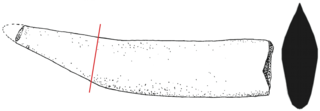
Banguela is a genus of azhdarchoid pterosaur from the Early Cretaceous period of what is now Brazil. Only one species is known, Banguela oberlii.
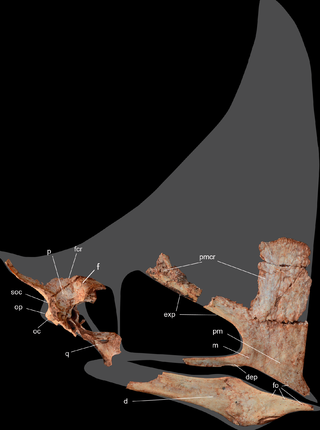
Caiuajara is an extinct genus of tapejarid pterosaur from the Early Cretaceous period of Brazil. It is known from a single type species, Caiuajara dobruskii.

Ornithocheiromorpha is a group of pterosaurs within the suborder Pterodactyloidea. Fossil remains of this group date back from the Early to Late Cretaceous periods, around 140 to 92.5 million years ago. Ornithocheiromorphs were discovered worldwide except Antarctica, though most genera were recovered in Europe, Asia and South America. They were the most diverse and successful pterosaurs during the Early Cretaceous, but throughout the Late Cretaceous they were replaced by better adapted and more advanced pterosaur species such the pteranodontids and azhdarchoids. The Ornithocheiromorpha was defined in 2014 by Andres and colleagues, and they made Ornithocheiromorpha the most inclusive clade containing Ornithocheirus, but not Pteranodon.
Linlongopterus is a genus of pteranodontoid pterodactyloid pterosaur from the Early Cretaceous of China. It is known from a partial skull and mandible first named and described in 2015 by Rodrigues et al.. The only known specimen was found in the Jiufotang Formation of the Liaoning Province or China, and lived around 120 million years ago. The full binomial of the taxon is Linlongopterus jennyae, with the generic name translating from the Chinese "forest" (lin) and "dragon" (long), and the Greek "wing" (pteros), while the species name honours Elfriede Kellner, nicknamed Jenny, a supporter of paleontology. The proper word for wing in ancient Greek is however pteron (πτερόν).

Nicorhynchus is a genus of anhanguerid pterosaur from the Cretaceous period. It contains two species, the type species, N. capito, from the Cambridge Greensand of England, and N. fluviferox from the Kem Kem Group of Morocco. These species were previously assigned to Coloborhynchus.
